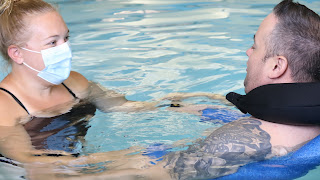What is Aquatic Therapy & What Are the Benefits?
If land-based exercise or therapy isn’t an option for you due to the nature of your condition or injury, getting in the pool may be of benefit. Aquatic therapy can be helpful for a host of medical issues including:
- Joint and chronic pain
- Muscle weakness
- Sports injuries
- Pre and post-surgical recovery
- Orthopedic disorders
- Neurological diagnoses
The key with water – especially warm water – is that it provides muscle relaxation. Once the muscles are relaxed, you may find you are able to do more in the water with less pain and have a greater range of motion. Decreased muscle tension also increases the ability to stretch muscles which means you are able to try, and be successful with, new exercises and in turn can increase your heart rate and overall cardiovascular health.
Working in the water also helps you “buy back” gravity. Aquatic specialists and therapists may start your therapy in the deep end of the pool, where you are completely buoyant and exercises are easier to perform. As you progress, you’ll work toward the shallow end, reintroducing a bit of gravity each time as you build adequate strength. Doing this allows you to work at your pace and progress when you are ready and able to.
Other benefits of aquatic therapy include:
- Warm pool temperatures help to decrease pain which allow increased blood flow which in turn increases healing.
- Aquatic exercise can be an energy-intensive work out because you are forced to use more energy to perform each exercise. The resistance of the water allows for increased strengthening and core activation with every movement.
- Compression of the water can help with swelling of lower extremities and improve circulation.
If you are seeking another therapy option, talk to your doctor or current therapist about treatment options and if aquatic therapy is among them. Not only can aquatic therapy be beneficial to your overall treatment and health, it can be a fun experience to look forward to doing!
Want more information like this? SIGN UP to receive CP
emails.




Comments
Post a Comment